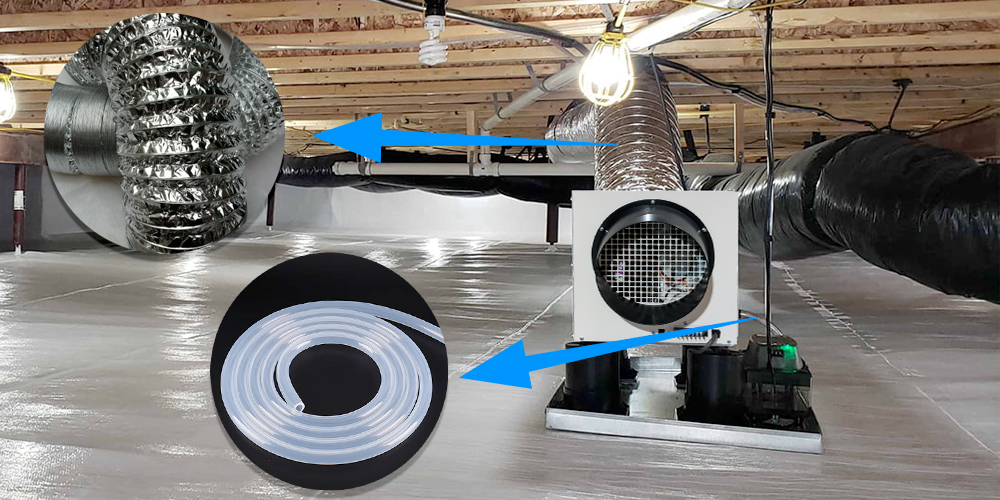
How to Install Whole Home Dehumidifier
Installing a whole house dehumidifier typically involves a more complex process compared to portable or room dehumidifiers. Here is a general step-by-step guide for installing a whole house dehumidifier:
1. Determine the appropriate location: Choose a suitable location for the dehumidifier. It's usually installed in the basement, attic, utility room, or HVAC system. Ensure there is sufficient space, access to power, and easy access for maintenance.
2. Gather the necessary tools and materials: You'll need tools such as a screwdriver, pliers, wire cutters, and a drill. The required materials may include mounting brackets, screws, electrical wires, ductwork, and insulation if needed.
3. Shut off the power: Before beginning any electrical work, turn off the power to the HVAC system at the main electrical panel.
4. Mount the dehumidifier: Install the mounting brackets on the chosen location according to the manufacturer's instructions. Mount the dehumidifier securely on the brackets using screws.
5. Connect to the HVAC system: Determine the best way to integrate the dehumidifier with your HVAC system. This can involve tapping into the return air duct or connecting it directly to the HVAC unit.
6. Electrical connections: Connect the dehumidifier to a power source. It may require wiring the dehumidifier to a dedicated electrical circuit or connecting it to an existing circuit. If you're not familiar with electrical work, it's recommended to hire a licensed electrician for this step.
7. Condensate drain: Most whole house dehumidifiers require a condensate drain to remove the extracted moisture. Connect the drain line to a suitable drain point, such as a floor drain or a sump pump. Ensure proper slope and secure connections to prevent leaks.
8. Insulate ductwork: If the dehumidifier is installed in an unconditioned space like the attic or basement, insulate the ductwork to prevent condensation and energy loss.
9. Test the installation: Once everything is connected, turn the power back on and test the operation of the whole house dehumidifier with pump. Check for any leaks, ensure proper drainage, and confirm that the unit is functioning as expected.
It's important to note that the dehumidifier installation process may vary depending on the specific model and the manufacturer's instructions. It's recommended to consult the installation manual provided by the dehumidifier manufacturer for detailed instructions tailored to your particular dehumidifier model.
How Does a Whole House Dehumidifier Work?
A whole house dehumidifier is designed to reduce and control the humidity levels throughout an entire home. It works in conjunction with the HVAC (Heating, Ventilation, and Air Conditioning) system to remove excess moisture from the air.
Here's a simplified explanation of how a whole house dehumidifier typically works:
1. Air intake: The dehumidifier is connected to the return air duct of the HVAC system. As the HVAC system operates and draws in air from the house, a portion of this air is diverted to the dehumidifier.
2. Air filtration: Before the air enters the dehumidifier, it usually passes through a filter to remove any dust, debris, or contaminants.
3. Cooling and dehumidification: The air enters the dehumidifier where it encounters a cooling coil. The cooling coil is similar to the evaporator coil in an air conditioner. The coil is chilled by a refrigeration system, causing the air to cool down. As the air cools, moisture in the air condenses onto the coil.
4. Condensate collection: The condensed moisture drips down from the cooling coil and is collected in a drip pan or condensate drain. The collected water is typically drained away through a pipe to a suitable drain point.
5. Reheating: After the moisture is removed, the air passes over a reheat coil. The reheat coil warms up the air to its original temperature, ensuring that the dehumidified air returned to the HVAC system is not excessively cool.
6. Air distribution: The dehumidified air is then reintroduced into the HVAC system and distributed throughout the house via the supply air ducts. The HVAC system circulates this dehumidified air, helping to maintain a comfortable and controlled humidity level throughout the home.
The dehumidifier is usually controlled by a humidistat, which measures the humidity levels in the air. When the humidity exceeds the desired level set on the humidistat, the dehumidifier activates to remove moisture. Once the desired humidity is reached, the dehumidifier will shut off until needed again.
By integrating with the HVAC system, a whole house dehumidifier provides comprehensive dehumidification for the entire home, rather than targeting specific rooms or areas like portable dehumidifiers. This helps maintain a balanced and comfortable indoor environment while reducing excess moisture and preventing issues like mold growth, musty odors, and structural damage caused by high humidity levels.
Post time: Jun-06-2023
 +86-13376814803
+86-13376814803  robert@hzhongtai.com
robert@hzhongtai.com 











